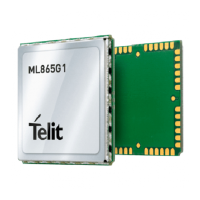The values set by other commands are stored in NVM outside the profile: some of them
are always stored, without issuing any &W, some others are stored by issuing specific
commands (+CSAS, #SLEDSAV, #SKTSAV, #ESAV); all these values are read at power-up.
In this document, each AT command description begins with an "AT Command short
overview table" in the following format:
Table 5:
This chapter focuses on the values that the saved Setting field can have and their meaning.
The meaning of the other fields will be described in the next chapter. The saved Setting
field can have one of the values listed below (for information about the AT instance
introduced hereafter, see the reference section of the #PORTCFG command):
Specific profile the parameters values set by the command are stored in the profile base
section. The stored values set is associated to the specific AT instance
used to enter the command. It is a profile used by the specific AT
instances.
Examples of the AT commands: +IPR, E, Q, V, X, &Y, etc.
The parameters values set by the command are stored in the profile
extended section. The stored values set is associated to the specific AT
instance used to enter the command. It is a profile used by the specific
AT instance.
Examples of the AT commands: +FCLASS, +CREG, +CLIP, #STIA, etc.
Common profile the parameters values set by the command are stored in the profile
extended section. The stored values set is not associated to the specific
AT instance used to enter the command. It is a profile shared between
the AT instances.
Examples of the AT commands: +CALM, #E2SLRI, #DVI, etc.
Auto the parameters values set by the command are automatically stored in
NVM, without issuing any storing AT command, and regardless of the
profile (unique values). The values are automatically restored at startup.
AT commands examples: +COPS, +CGQREQ, #SCFG, etc.
In some cases, the parameters values are stored in the file system.
AT commands examples: #TEMPCFG, #TEMPMON, etc.

